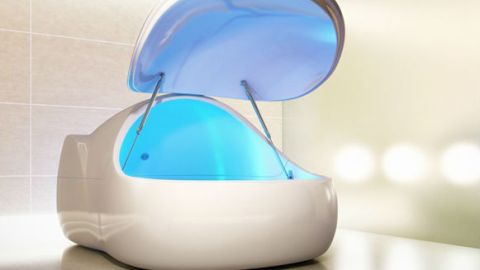Turn off Your Mind, Relax, and Float. Sensory Deprivation and What It Can Do for You.

You may have heard of a new kind of therapy from your more “new age” friends, “Sensory Deprivation Tanks”. While it sounds like a form of torture that might have been used at Guantanamo Bay, many people swear to its benefits. Boldly going into the void to gaze into the abyss for an hour or two.
But, what is it?
The idea is rather simple, an enclosed tank filled with water which is saturated with Epsom salt. The tank is generally placed in a room where light and sound can be filtered out. For a person inside the tank the effect is near total darkness, silence, and the sensation of floating effortlessly. The water in the tank is kept at or near body temperature, removing even the feeling of heat or cold on the skin. As we are bombarded with sensory information every other moment of our lives, entering a tank is a unique experience. If you want a report by Big Think author Derek Beres on being in a tank, you can read it here.
When did this start?
The tanks were invented by Dr. John C. Lilly in 1954 when he worked for NIMH as a neuropsychiatrist. Lilly had a lifelong interest in the strange, including teaching dolphins to speak English, taking large doses of psychedelic drugs, and even the potential problems of rouge AI…. in the seventies. There was a method to his madness however, and the tanks are one of his several successful ideas. He termed the act of sitting in a sensory deprived area Restricted Environmental Stimulation Therapy, or REST.
Initially his tanks were used to test the effects on the brain and psyche of sensory deprivation for long periods of time. In the 1970’s floating centers opened for use by the general public, though many of these closed in the 1980’s due to sanitation concerns. Today, there is a resurgence in popularity for the act of “floating”. Centers can be found in dozens of countries, and tanks for home use are increasingly popular.
What does it do?
While it is often promoted as an alternative medicine that can fix everything, or as a gateway to psychic and paranormal phenomena as seen on Stranger Things, the limited studies on the practice show that it is good for stress relief, and may be a tool for people looking to stop smoking and drinking if used alongside other methods. People who practice meditation also report that the tanks are excellent tools for practicing mindfulness. The high concentration of Epsom Salt in the water is also liable to make your skin a touch softer. While many athletes claim it helps them reduce muscle pain, the data on that is still lacking.
Claims that it can cause the development of psychic powers, communication with dolphins or the dead, devolution into simian form, or that fantastic visual hallucinations are a key feature of the use of such tanks are overstated to say the least. These ideas are prevalent in popular culture, an effect of the psychedelic and often pseudo-scientific origins of the practice. While many spas that offer sensory deprivation pitch the session as a unique and relaxing soak, some still hint at the idea of the impossible trying to make a sale.
Restricted Environmental Stimulation Therapyhas been around for more than fifty years. Only now are the potential benefits of sensory deprivation being made available to the general public. While the benefits can be overstated, the meta-studies show that it does reduce stress. Is it for everyone? No, the idea of being without a phone for forty-five minutes terrifies many, let alone being without anything external.
But, if you want to escape a key factor of your existence, sensory input, for even a little while- sensory deprivation tanks can offer that escape.





